On an overcast day in November 2014, Jason Goldberg sat at his desk in NYC, poring over the term sheet to sell his company, Fab.com.
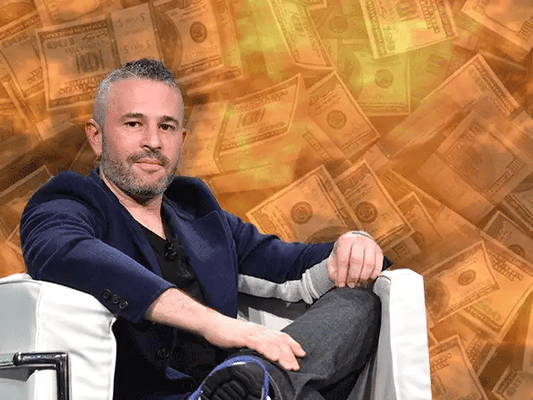
This moment was meant to be the culmination of years of hard work — countless late nights spent strategizing, analyzing financials, and meeting with investors.
Fab had raised $336m since rebranding itself as an ecommerce platform in 2011. At one point, it had been a unicorn, valued at $1B. It had 750 employees on multiple continents, a schmaltzy HQ in New York, and an enormous warehouse stocked with millions of products.
Now, the company was selling for less than one-tenth of its original valuation.
As a serial entrepreneur, Goldberg had experienced ups and downs before. But this was different. This was a screw-up of massive proportions.
How had it all gone so wrong?
Fab’s rise and fall is a case study in the perils of over-funding. But it’s also a story about a serial entrepreneur who has refused to give up in the wake of failure.
The ‘geeky’ kid on the block
Growing up in Rockville, Maryland, a DC suburb, Goldberg was always the “first kid in the neighborhood to get the newest computer when it came out.” He spent his early days programming on an Atari 400 with his dad.
Later, as an undergrad at Emory University, he was drawn to a different field of machinery: politics.
In 1991, Goldberg took a hiatus from college to work on Bill Clinton’s presidential campaign.
When Clinton won, Goldberg was hired as a special assistant to the president’s chief of staff, Erskine Bowles. He was there when the internet was first implemented at the White House in 1994 — and he witnessed, firsthand, the gold rush of opportunities it ushered in.
At the height of the dot-com bubble in 1998, he packed his bags for California, where he simultaneously earned an MBA at Stanford and developed digital strategies for AOL Time Warner and T-Mobile.
Then, he decided to strike out on his own.
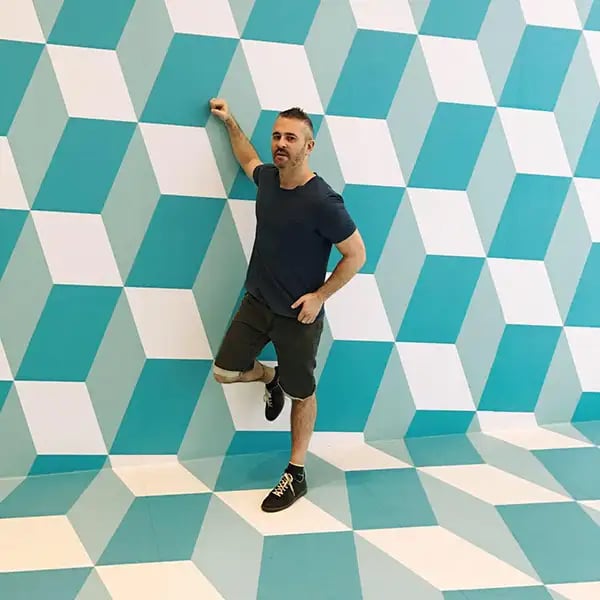
Jason Goldberg in 2016 (Facebook)
By 2002, Goldberg felt he had the requisite tools to found his own startup.
After 2 years of planning, he and his close friend, Phillip Bogle, moved to Seattle and launched Jobster, a B2B job referral site.
“Reid Hoffman [of LinkedIn] and I had very similar ideas at the same time,” Goldberg told The Hustle in 2017. “His approach was to build out a consumer network — a ‘who knows who knows who’ that could be monetized. We were focused on the enterprise side.”
At first, Jobster was a big hit.
The company raised $52.5m from investors and was cited as one of Seattle’s fastest-growing companies. In an unorthodox move for a young startup, Goldberg used the new capital to buy out a series of other companies and began scaling the team at lightning speed.
But a big problem belied the company’s veneer of success.
“We were so focused on growth that the product itself suffered,” Goldberg said. “We were good at selling a vision, but we weren’t able to deliver on the products we promised.”

A screenshot of Jobster.com, circa 2008 (Wayback Machine)
As Jobster struggled to figure out its business model, Goldberg had to lay off ~40% of the company and slash costs. In 2007, he stepped down as CEO. Eventually, the company sold for “pennies on the dollar.”
Once heralded as Seattle’s next big tech titan, Goldberg had become the city’s pariah-in-residence.
“The blame was all mine,” he said. “I really learned that no amount of marketing or sales could make up for not getting the product right.”
On to the next one
After Jobster, Goldberg found himself marooned in Seattle.
“The city didn’t have a developed culture that [it] was OK to fail,” he said. “I was very vocal about failure, and it didn’t go over well there.”
So, he took off for New York.
Goldberg wasted little time getting back on the horse. In early 2008, he founded Socialmedian — a personalized news filter that aggregated news stories from around the web and organized them into categories.
This time, instead of seeking a massive infusion of capital, Goldberg relied on a relatively small seed round of $560k.
When Lehman Brothers collapsed, sparking an international financial crisis, Goldberg anxiously called 3 companies who’d previously offered to buy him out and told them the company was up for sale.
The best offer came from Germany-based social network Xing: $4m in cash, and an earn-out valued at up to $3.5m. Goldberg took the deal.

Goldberg found better luck in NYC than in Seattle (Pixabay)
“Socialmedian was everything Jobster wasn’t,” he says. “It was about keeping things small and focusing on the product. And in the end, it worked out for us.”
As part of the deal, Goldberg relocated to Germany and joined Xing as a VP. Eventually, he was promoted to CTO and helped boost the company’s share price from $30 to $70.
He’d gotten his mojo back — or so it seemed.
The big fail
By 2010, the serial entrepreneur was again ready to strike out on his own.
So, he teamed up with a designer named Bradford Shellhammer and launched Fabulis, a social network for gay men.
Between January and December of that year, the company raised $2m in funding from investors. But a year in, Goldberg realized the company wasn’t catching on like he thought it would.
“My philosophy was that if you can’t do something in a year, you should just throw it out and do something else,” he says. “You can’t iterate your way to a business model.”
Over dinner, Goldberg and Shellhammer stepped back to reassess their direction, asking themselves 3 questions:
- What are we most passionate about?
- It is something we can be the best at?
- What is a big untapped market we can add value to?
On a dinner napkin, the duo sketched out the one thing at the intersection of these 3 questions: design.
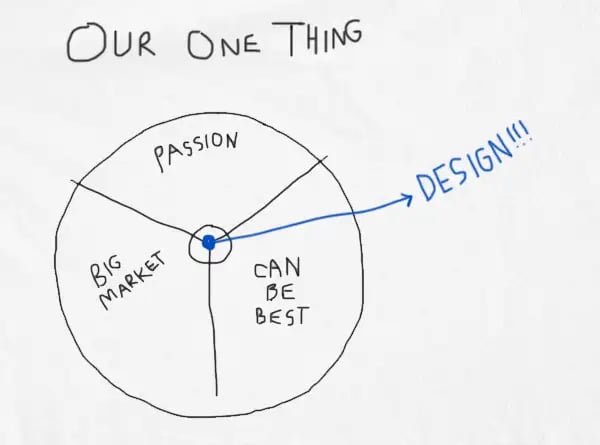
The dinner napkin brainstorm that led to the creation of Fab.com (recreation of image via Goldberg)
One week after that brainstorm, Goldberg shut down Fabulis, letting his investors know he was doubling down on a new concept — a curated, design-focused ecommerce platform called Fab.com.
The idea was to curate eye-catching goods from boutique designers and offer flash sales centered around daily design inspirations.
Under their model, Goldberg and Shellhammer sold limited amounts of inventory at a discount for one- or 2-day periods, testing the waters for larger bulk orders. They thrived on offering items people couldn’t find anywhere else — everything from throw pillows to a $1,775 martini glass chandelier.
On June 9, 2011, the website went live. And in very short order, its proof of concept was validated:
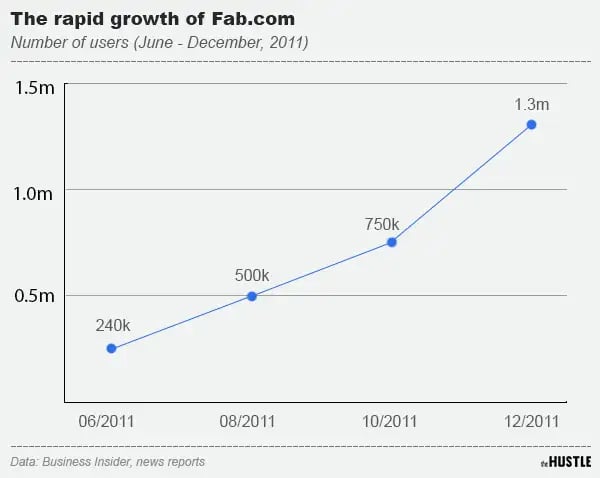
The Hustle
Fab reached 1m users in just 5 months — faster than goliaths like Facebook, Twitter, and Groupon. The company began to generate buzz as one of the “fastest-growing startups in the world.”
The sales rose in tandem with user growth: its first year, Fab’s revenue increased by 6x, from $18m to $112m.
Investors were attracted like moths to a lantern. By the end of 2012, Fab raised nearly $170m and was valued at upwards of $500m:
- August 2011: $7.7m (led by Menlo Ventures)
- December 2011: $40m (led by Andreessen Horowitz)
- July 2012: $105m (led by Atomico)
- Nov 2012: $15m (led by VTB Capital)
The company basked in the limelight.
Goldberg traveled around Europe, where he gave a presentation titled “From Zero to Hero in 9 Months.” He invested in a 2-story office space in NYC and a massive inventory warehouse in New Jersey. The team grew to more than 750 employees.
And then, everything came crashing down.
Fatal mistakes
Behind the scenes, Fab’s board members weren’t happy.
The company was spending astronomical sums of money on logistics, inventory, and expansion— some $14m per month at its peak. Goldberg had also fallen shy of the company’s $140m annual sales goal for 2012.
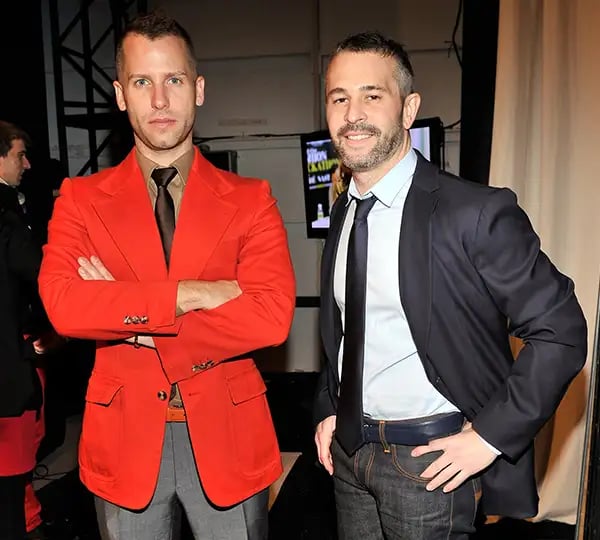
Bradford Shellhammer (left) and Jason Goldberg (right) at an event in NYC in 2013 New York City (Stephen Lovekin/Getty Images)
In early 2013, Goldberg was presented 2 options by his board:
- Focus on the US market only, and target profitability around $150m in sales, or
- Push for 100% YoY growth and expand fast globally
The vote was unanimously in favor of option No. 2.
That summer, Fab raised a $165m Series D, bulking up its total investments to $330m+, and valuing the company at $900m+.
And under pressure from board members and advisors, Goldberg set out to rapidly build out the company’s international presence. This resulted in several key mistakes:
- Spending $60m-$100m on 3 “clone” competitors and making a premature push into the European market
- Expanding inventory from 1k items to 11k+ items, and losing the “curation edge” that made it special
“At first, hardly anything on Fab was on Amazon,” Goldberg told us in 2017. “By 2013, 80-90% of the products we sold were on Amazon — with lower prices and free 2-day shipping.”
“I remember we were all sitting around doing a preview of our products, and my team was like, ‘This is not inspiring at all,’” he continued. “Our best-selling product was a T-shirt with a giant picture of an animal on it. Just crappy stuff. And I thought, ‘Is this really going to work out?’”
By October of 2013, Fab had burned through $200m of its $336m in funding.
In a letter to his team, Goldberg expressed major concerns.
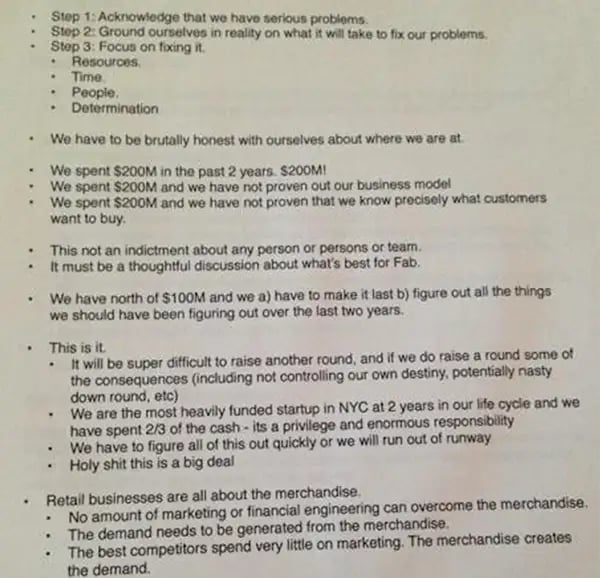
An excerpt from a letter circulated by Goldberg to Fab staff (Business Insider)
“We have a serious problem,” he wrote. “We spent $200m in the past 2 years… and we have not proven out our business model. We are the most heavily funded startup in NYC in our life cycle and we have spent ⅔ of the cash… Holy shit this is a big deal.”
In the letter, he expanded on several mistakes he’d made:
- I guided us to go too fast.
- I enabled us to lose our core focus.
- I didn’t insist on honing in on our target customer.
- I spent too much on marketing before we got the consumer value proposition right.
An unfortunate exit
Goldberg’s co-founder, Shellhammer, a “quirky guy, who set the style of the company,” eventually grew unhappy and departed on mutual terms.
By December 2013, only 150 of Fab’s 700 employees remained.
“It was death by 1,000 cuts,” says Goldberg. “It was many of the same problems from before: We grew too fast, went international too fast, built out of warehouses too fast.”
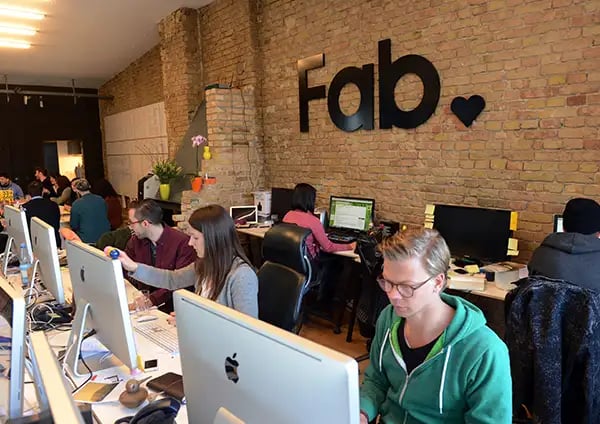
The Fab.com office in Berlin, Germany, in 2013 (Jens Kalaene via Getty Images)
The next year was focused on damage control.
“There was a point in 2014 where we had a chart that showed we’d reduced the burn rate from $11m to $1m a month,” says Goldberg. “One of the board members turned to me and said, ‘This is the best chart I’ve ever seen at this company.’ That was tough.”
By June 2014, Goldberg had begun working on another project within Fab — a new ecommerce company called Hem, which would focus on “original, high-end home goods,” which made up ~40% of Fab’s product listings.
He decided to invest what was left of Fab’s funding — about $80m — into Hem, and sell off Fab’s remaining assets.
In early 2015, he finalized a deal with PCH Innovations to sell for a reported $15m — a fraction of Fab’s one-time $1B valuation.
A year later, Hem would sell for even less. Goldberg’s unicorn was dead.
Starting over
What does an entrepreneur do after burning through $330m+?
“My personality is that I always want to make everyone happy,” Goldberg said in 2017. “I let down our investors, and it was a terrible feeling.”
At the same time, Goldberg said this “make everyone happy” attitude led to strong bonds with his investors that last to this day.
“Give some of those early investors a call and ask him what they think of Jason Goldberg,” he said. “I’m sure they would invest in a Jason Goldberg company again.”
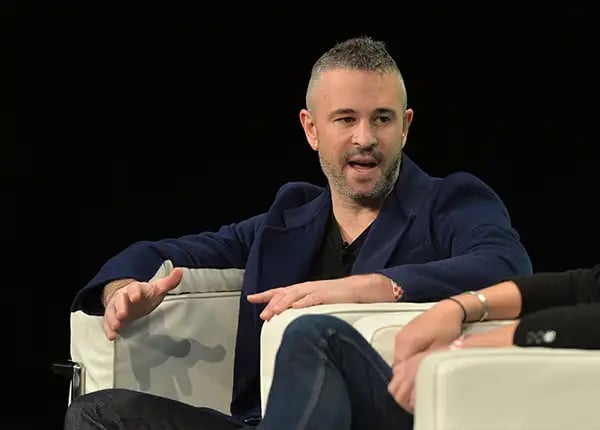
Goldberg at 2014 TechCrunch Disrupt Europe/London (Anthony Harvey/Getty Images for TechCrunch)
Goldberg’s track record since Fab backs that up.
In 2016, he raised $3m from investors (including some of the same investors who’d bet on Fab) to launch a social messaging app called Pepo. That same year, he launched a blockchain technology platform (OST) and molded Pepo into an app to help makers in the crypto space.
He was thwarted again — this time, by the hardships of COVID-19.
So, he raised $2.2m to build out an all-in-one platform to help fitness instructors start online businesses.
Fittingly, he called it Moxie — a word that connotes a “fighting spirit” and a refusal to give up in the face of adversity.
“I’m not the kind of person who is going to bury my head in the sand, lie on the beach, and tune out,” he said. “I want to build stuff.”
